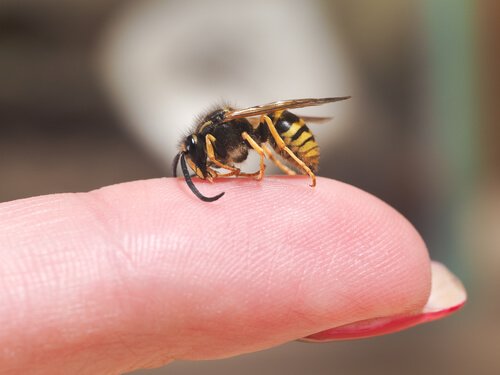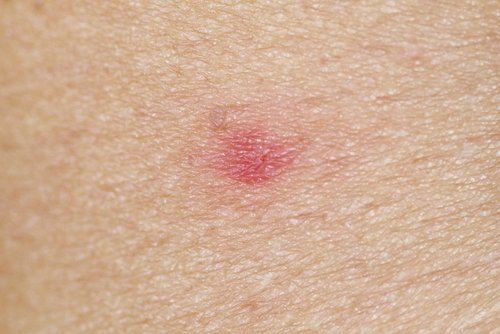Wasp Stings: Prevention and Treatment

Bee and wasp stings are something that many parents worry about. This is partly due to the fact that they don’t know how their child’s body will react to the sting.
In these cases, adults often wonder whether they should take their child for emergency treatments, or if they can treat them at home. They’ll also need to take into account how their child is reacting to the sting. That’s why parents really want to know what to do if a wasp stings their child.
Spring and summer are when there are more wasps around. These are also the months when children tend to go outside to play, And so, naturally, there’s always a greater risk of getting bee or wasp stings.
That’s why you need to know what to do when it happens, so you can deal with this little “emergency” effectively.
Know your enemy
The first thing you should do is not lose your cool. It’s good for you to know that, even if the child is allergic, there’s no reason to panic. If a wasp stings him, you’ll have enough time to evaluate the situation and give him the necessary attention. In theory, wasp stings should be an emergency.
A good first step is to know what type of enemy you’re facing. Wasps are hymenopteran insects. They’re from the bee family. But unlike their relatives, they have a straight stinger that doesn’t stay behind in their victim’s skin.

Because of this, they can sting someone several times consecutively. This is what could complicate the situation in comparison to what happens with a bee sting. When a bee stings you, a part of its abdomen detaches itself, and it dies.
Both bees and wasps inject a substance containing components that cause strong pain and inflammation. However, if you treat the sting correctly, it rarely carries major consequences.
What to do about wasp stings?
Here are some tips for treating wasp stings in children:
- Clean the area with plenty of fresh water and a mild soap.
- It’s not common for a wasp stinger to remain in the child’s skin after stinging you. If it does, however, you should remove it with some sterile tweezers. You shouldn’t pinch the area, nor should you fall for the popular myth of sucking the wound to extract the sting. This would only contaminate the wound and cause more problems.
- After that, you should disinfect the area again, just to be sure that no particles remain that could cause infection.
- You can apply special creams containing ammonia, which helps get rid of the itching and burning sensation.
- Ice is also a good way of reducing the discomfort.
- In case of suspecting an allergic reaction: If you notice that your child has trouble breathing or has red welts in various areas of their body, the best thing to do is take him for emergency treatment. This way you may avoid a more serious situation or anaphylactic shock.
“Wasps are from the bee family, but they have a smooth stinger that doesn’t stay stuck in the skin of the individual they attack”

What you should teach your little ones about wasps
No one is exempt from getting bitten or stung, but we should still be teaching children about the dangers and painful consequences of disturbing or annoying these insects. It’s very important that children know:
- They should never attempt to interfere with a beehive or wasp’s nest, not even by throwing stones. They often make the mistake of thinking that distance will give them an advantage in order to run away.
- If one of these insects comes near them, they shouldn’t move around or start waving their hands in the air to try to get them away. This will only encourage them to attack.
- If you’ve spent the day by the pool, a river or on the beach, it’s a good idea to shake their clothes out before they get dressed. Wasps can easily be hiding in them.
- On outdoor walks or during the summer, it’s preferable to keep all food covered. It’s especially important to cover sweet fruits such as bananas, which is one of wasps’ favorites.
Finally, if you know that your child is prone to suffer severe allergic reactions, it’s advisable to talk with your pediatrician. He’ll advise you about the best sort of emergency first aid kit you can have with you, and an emergency plan for delicate cases like yours.
Bee and wasp stings are something that many parents worry about. This is partly due to the fact that they don’t know how their child’s body will react to the sting.
In these cases, adults often wonder whether they should take their child for emergency treatments, or if they can treat them at home. They’ll also need to take into account how their child is reacting to the sting. That’s why parents really want to know what to do if a wasp stings their child.
Spring and summer are when there are more wasps around. These are also the months when children tend to go outside to play, And so, naturally, there’s always a greater risk of getting bee or wasp stings.
That’s why you need to know what to do when it happens, so you can deal with this little “emergency” effectively.
Know your enemy
The first thing you should do is not lose your cool. It’s good for you to know that, even if the child is allergic, there’s no reason to panic. If a wasp stings him, you’ll have enough time to evaluate the situation and give him the necessary attention. In theory, wasp stings should be an emergency.
A good first step is to know what type of enemy you’re facing. Wasps are hymenopteran insects. They’re from the bee family. But unlike their relatives, they have a straight stinger that doesn’t stay behind in their victim’s skin.

Because of this, they can sting someone several times consecutively. This is what could complicate the situation in comparison to what happens with a bee sting. When a bee stings you, a part of its abdomen detaches itself, and it dies.
Both bees and wasps inject a substance containing components that cause strong pain and inflammation. However, if you treat the sting correctly, it rarely carries major consequences.
What to do about wasp stings?
Here are some tips for treating wasp stings in children:
- Clean the area with plenty of fresh water and a mild soap.
- It’s not common for a wasp stinger to remain in the child’s skin after stinging you. If it does, however, you should remove it with some sterile tweezers. You shouldn’t pinch the area, nor should you fall for the popular myth of sucking the wound to extract the sting. This would only contaminate the wound and cause more problems.
- After that, you should disinfect the area again, just to be sure that no particles remain that could cause infection.
- You can apply special creams containing ammonia, which helps get rid of the itching and burning sensation.
- Ice is also a good way of reducing the discomfort.
- In case of suspecting an allergic reaction: If you notice that your child has trouble breathing or has red welts in various areas of their body, the best thing to do is take him for emergency treatment. This way you may avoid a more serious situation or anaphylactic shock.
“Wasps are from the bee family, but they have a smooth stinger that doesn’t stay stuck in the skin of the individual they attack”

What you should teach your little ones about wasps
No one is exempt from getting bitten or stung, but we should still be teaching children about the dangers and painful consequences of disturbing or annoying these insects. It’s very important that children know:
- They should never attempt to interfere with a beehive or wasp’s nest, not even by throwing stones. They often make the mistake of thinking that distance will give them an advantage in order to run away.
- If one of these insects comes near them, they shouldn’t move around or start waving their hands in the air to try to get them away. This will only encourage them to attack.
- If you’ve spent the day by the pool, a river or on the beach, it’s a good idea to shake their clothes out before they get dressed. Wasps can easily be hiding in them.
- On outdoor walks or during the summer, it’s preferable to keep all food covered. It’s especially important to cover sweet fruits such as bananas, which is one of wasps’ favorites.
Finally, if you know that your child is prone to suffer severe allergic reactions, it’s advisable to talk with your pediatrician. He’ll advise you about the best sort of emergency first aid kit you can have with you, and an emergency plan for delicate cases like yours.
This text is provided for informational purposes only and does not replace consultation with a professional. If in doubt, consult your specialist.








